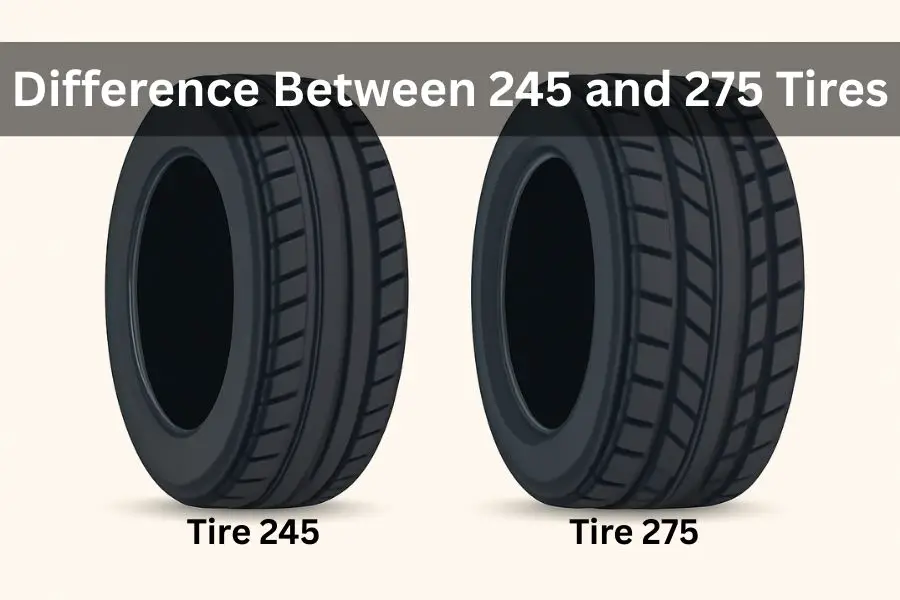When choosing tires, understanding the differences between tire sizes is crucial for vehicle performance, comfort, and efficiency. One common comparison is between 245 and 275 tires. These numbers refer to the tire’s width in millimeters. The primary difference between the two is that 275 tires are wider than 245 tires, affecting their overall performance. But how does this difference impact your driving experience, and which tire is best for you? This article will break down these key differences to help you make an informed decision.
Whether you’re driving a compact sedan or a high-performance SUV, tire size plays a crucial role in everything from fuel efficiency to handling. Both 245 and 275 tires have distinct advantages depending on your vehicle and driving conditions. Let’s dive into how they compare.
What Do Tire Numbers Mean?
Tire sizes, like 245/45R17 or 275/45R17, follow a standard format to represent key measurements.
-
The first number (245 or 275) indicates the tire width in millimeters.
-
The second number (45 in this example) represents the aspect ratio, or the height of the sidewall as a percentage of the tire’s width.
-
The R stands for radial construction, the most common type of tire.
-
The last number (17) refers to the diameter of the wheel in inches.
These numbers can affect various aspects of your vehicle’s performance, including handling, comfort, and efficiency.
Key Differences Between 245 and 275 Tires
Tire Width:
-
245 Tires:
Ideal for compact to mid-sized cars, offering a balance between performance, comfort, and fuel efficiency. They provide enough grip for normal driving conditions without sacrificing ride quality. -
275 Tires:
These wider tires are usually found on larger vehicles like SUVs, trucks, or sports cars. Wider tires provide better road grip, especially in off-road or performance driving conditions. However, they can make the ride feel firmer due to the reduced sidewall height.
Impact on Handling and Comfort:
-
245 Tires:
Offer a more comfortable ride with less road noise and better fuel efficiency. They are a solid choice for daily commuting and regular driving. -
275 Tires:
While offering better handling and grip, particularly in wet or dry conditions, they might decrease ride comfort due to their increased width. Wider tires create more road contact, which can result in a slightly rougher ride.
Fuel Efficiency:
-
245 Tires:
With their narrower width, 245 tires typically result in better fuel economy since there’s less rolling resistance. This is ideal for city driving where fuel efficiency is a priority. -
275 Tires:
The wider the tire, the more resistance it generates. Wider tires like 275 tires can reduce fuel efficiency due to increased friction between the tire and the road.
Tire Pressure and Inflation:
-
245 Tires:
Generally require lower tire pressures and offer a softer ride due to their smaller width. -
275 Tires:
These tires require higher inflation pressures to ensure optimal performance and prevent wear, especially when carrying heavy loads or traveling at high speeds.
Which Tires Are Better for Your Vehicle?
Choosing between 245 and 275 tires depends largely on your vehicle type and driving habits.
Choosing 245 Tires:
-
Best for Smaller and Lighter Vehicles: Cars like sedans, hatchbacks, and compact SUVs benefit from 245 tires as they balance comfort and performance.
-
Advantages: They provide better fuel economy, smoother rides, and are easier on the wallet without compromising everyday driving comfort.
Choosing 275 Tires:
-
Ideal for Larger Vehicles: Trucks, SUVs, and performance-oriented vehicles generally prefer 275 tires for their superior grip and handling capabilities.
-
Advantages: They are perfect for those who often drive in challenging conditions, such as off-road or wet weather. They also enhance cornering abilities and traction for high-performance driving.
Impact on Vehicle Performance
Handling:
-
Wider tires (275) provide better traction, helping vehicles grip the road better. This is especially important in wet, snowy, or off-road conditions.
-
For those looking for improved cornering and stability, 275 tires will often outperform 245 tires.
Comfort and Noise:
-
245 tires provide a smoother ride due to their smaller width, absorbing road imperfections better. They also produce less road noise.
-
275 tires offer improved handling but tend to increase road noise and reduce ride comfort, especially on rough roads.
Speedometer Accuracy:
-
Tire size changes (like going from 245 to 275) can affect your vehicle’s speedometer accuracy. Wider tires may cause your speedometer to read slower than your actual speed, especially when changing the overall diameter of the tire.
How to Choose Between 245 and 275 Tires?
When making your decision, consider the following factors:
-
Vehicle Type: Larger vehicles like trucks or SUVs are typically designed for wider tires (275), while smaller cars do better with 245 tires.
-
Driving Conditions: If you frequently drive in wet, snow-covered, or off-road conditions, 275 tires may be better. For daily city driving, 245 tires may suffice.
-
Fuel Economy vs. Handling: Choose 245 tires for better fuel efficiency, and opt for 275 if you prioritize superior handling.
Frequently Asked Questions (FAQs)
1. What is the main difference between 245 and 275 tires?
The primary difference is the width: 245 tires are narrower, offering better fuel efficiency and a smoother ride, while 275 tires are wider, providing better traction and handling.
2. Can I replace 245 tires with 275 tires?
It’s possible, but you need to ensure that the wider tires fit your vehicle. Consult a mechanic or check your car’s specifications to avoid issues with clearance, speedometer accuracy, and handling.
3. Do wider tires provide better traction?
Yes, 275 tires typically provide better traction than 245 tires due to the increased contact area with the road, which is beneficial in off-road, wet, or performance driving conditions.
4. Will 275 tires affect my car’s fuel economy?
Yes, 275 tires can lower your vehicle’s fuel economy because of increased rolling resistance, requiring more energy to keep the car moving.
5. Which tire size is best for handling in rainy conditions?
275 tires are usually better for wet weather handling as their wider surface area allows for better grip, but tread pattern and tire quality are also important.
Conclusion
Choosing the right tire size between 245 and 275 depends on a variety of factors such as vehicle type, driving conditions, and performance needs. 245 tires are great for everyday driving, providing comfort and efficiency, while 275 tires offer enhanced handling and grip for larger vehicles or performance driving. Consider consulting with a tire expert to make the best choice for your car, ensuring safety, efficiency, and performance on the road.

Bruce William is a professional content writer and vehicle engineer with extensive car maintenance and repair knowledge. His expertise spans all vehicle parts, offering practical solutions for various automotive issues. Bruce provides valuable insights through his website articles to help readers maintain their cars for optimal performance and longevity.

